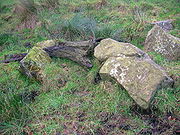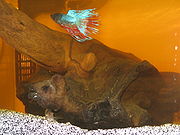
Bog oak
Encyclopedia

Peat
Peat is an accumulation of partially decayed vegetation matter or histosol. Peat forms in wetland bogs, moors, muskegs, pocosins, mires, and peat swamp forests. Peat is harvested as an important source of fuel in certain parts of the world...
bog
Bog
A bog, quagmire or mire is a wetland that accumulates acidic peat, a deposit of dead plant material—often mosses or, in Arctic climates, lichens....
s and preserved from decay
Decomposition
Decomposition is the process by which organic material is broken down into simpler forms of matter. The process is essential for recycling the finite matter that occupies physical space in the biome. Bodies of living organisms begin to decompose shortly after death...
by the acid
Acid
An acid is a substance which reacts with a base. Commonly, acids can be identified as tasting sour, reacting with metals such as calcium, and bases like sodium carbonate. Aqueous acids have a pH of less than 7, where an acid of lower pH is typically stronger, and turn blue litmus paper red...
ic and anaerobic bog conditions, sometimes for hundreds or even thousands of years. The wood is usually stained brown by tannin
Tannin
A tannin is an astringent, bitter plant polyphenolic compound that binds to and precipitates proteins and various other organic compounds including amino acids and alkaloids.The term tannin refers to the use of...
s dissolved in the acidic water. Bog-wood represents the early stages in the fossil
Fossil
Fossils are the preserved remains or traces of animals , plants, and other organisms from the remote past...
isation of wood, with further stages ultimately forming lignite
Lignite
Lignite, often referred to as brown coal, or Rosebud coal by Northern Pacific Railroad,is a soft brown fuel with characteristics that put it somewhere between coal and peat...
and coal
Coal
Coal is a combustible black or brownish-black sedimentary rock usually occurring in rock strata in layers or veins called coal beds or coal seams. The harder forms, such as anthracite coal, can be regarded as metamorphic rock because of later exposure to elevated temperature and pressure...
over a period of many millions of years. Bog-wood may come from any tree species naturally growing near or in bogs, including oak
Oak
An oak is a tree or shrub in the genus Quercus , of which about 600 species exist. "Oak" may also appear in the names of species in related genera, notably Lithocarpus...
(Quercus – "bog oak"), pine (Pinus), yew
Taxus
Taxus is a genus of yews, small coniferous trees or shrubs in the yew family Taxaceae. They are relatively slow-growing and can be very long-lived, and reach heights of 1-40 m, with trunk diameters of up to 4 m...
(Taxus), swamp cypress (Taxodium
Taxodium
Taxodium is a genus of one to three species of extremely flood-tolerant conifers in the cypress family, Cupressaceae...
) and kauri (Agathis
Agathis
The genus Agathis, commonly known as kauri or dammar, is a relatively small genus of 21 species of evergreen tree. The genus is part of the ancient Araucariaceae family of conifers, a group once widespread during the Jurassic period, but now largely restricted to the Southern Hemisphere except for...
). Bog-wood is often removed from fields etc. and placed in clearance cairn
Clearance cairn
A Clearance Cairn is an irregular and unstructured collection of fieldstones which have been removed from arable land or pasture to allow for more effective agriculture and collected into a usually low mound or cairn. Commonly of Bronze Age origins, these cairns may be part of a cairnfield where...
s.
Uses
Because bog-wood can remain undecayed for thousands of years it is of use in dendrochronologyDendrochronology
Dendrochronology or tree-ring dating is the scientific method of dating based on the analysis of patterns of tree-rings. Dendrochronology can date the time at which tree rings were formed, in many types of wood, to the exact calendar year...
, often providing records much older than living trees. Wooden artifacts lost or buried in bogs become preserved as bog-wood, and are important in archaeology
Archaeology
Archaeology, or archeology , is the study of human society, primarily through the recovery and analysis of the material culture and environmental data that they have left behind, which includes artifacts, architecture, biofacts and cultural landscapes...
.

Joinery
Joinery may refer to:* Woodworking joints or other types of mechanical joints * The work of the joiner, the fabrication and installation of fittings in buildings with materials such as wood and aluminum * In Australia and New Zealand, a joinery is also the generic term for a business which...
to make furniture or wood carving
Wood carving
Wood carving is a form of working wood by means of a cutting tool in one hand or a chisel by two hands or with one hand on a chisel and one hand on a mallet, resulting in a wooden figure or figurine, or in the sculptural ornamentation of a wooden object...
. Bog-wood sometimes has aesthetically interesting shapes (similar to driftwood
Driftwood
Driftwood is wood that has been washed onto a shore or beach of a sea or river by the action of winds, tides, waves or man. It is a form of marine debris or tidewrack....
) and as such may be use as ornaments. As bog-wood dries out, it may crack or split, but this does not necessarily detract from the aesthetic qualities of a bog-wood sculpture. It is a traditionally favoured wood for the carving of dirks (bìodagan) and sgianan dubha in the Scottish Highlands
Scottish Highlands
The Highlands is an historic region of Scotland. The area is sometimes referred to as the "Scottish Highlands". It was culturally distinguishable from the Lowlands from the later Middle Ages into the modern period, when Lowland Scots replaced Scottish Gaelic throughout most of the Lowlands...
due to its natural colour. It is also used to make tobacco pipes.
Bog-wood is used in aquaria
Aquarium
An aquarium is a vivarium consisting of at least one transparent side in which water-dwelling plants or animals are kept. Fishkeepers use aquaria to keep fish, invertebrates, amphibians, marine mammals, turtles, and aquatic plants...
for ornaments, providing hiding places for fish and a growing surface for plants such as Java fern
Microsorum pteropus
Microsorum pteropus, commonly known as Java fern an aquatic fern from southeast Asia, is highly variable with several different geographic varieties that vary in leaf size and shape. It is found attached to roots and rocks in nature....
. Additionally, the leaching of organic compounds such as tannins into the water causes a brown colouration. It is also a staple part of the diet for Pleco, Ancistrus
Ancistrus
Ancistrus is a genus of freshwater fish in the family Loricariidae of order Siluriformes. Fish of this genus are commonly known as the bushynose or bristlenose plecos.-Taxonomy:The type species is Ancistrus cirrhosus...
and Panaque
Panaque
The genus Panaque contains a small number of small to medium sized South American armoured catfishes that are notable for being among the very few vertebrates that feed extensively on wood. In addition, algae and aufwuchs are an important part of the diet, and they use their rasping teeth to...
catfish as it aids digestion.
During the nineteenth century bog oak was used to make carved decorative items such as jewelry.
See also
- Aquarium substratesSubstrate (aquarium)The substrate of an aquarium refers to the material used on the tank bottom. It can affect water chemistry, filtration, and the well-being of the aquarium's inhabitants, and is also an important part of the aquarium's aesthetic appeal...
- DriftwoodDriftwoodDriftwood is wood that has been washed onto a shore or beach of a sea or river by the action of winds, tides, waves or man. It is a form of marine debris or tidewrack....
- MopaneMopaneThe mopane or mopani tree grows in hot, dry, low-lying areas, in elevation, in the far northern parts of southern Africa, into South Africa, Zimbabwe, Mozambique, Botswana, Zambia, Namibia, Angola and Malawi. The tree only occurs in Africa and is the only species in genus Colophospermum...
wood, recovered from deserts and often sold as an alternative to bogwood for aquaria; it is sometimes incorrectly labelled as bogwood or charred bogwood. - Sweet TrackSweet TrackThe Sweet Track is an ancient causeway in the Somerset Levels, England. It was built in 3807 or 3806 BC and has been claimed to be the oldest road in the world. It was the oldest timber trackway discovered in Northern Europe until the 2009 discovery of a 6,000 year-old trackway in Belmarsh Prison...
, a timber causeway in Somerset, England, its timbers preserved in waterlogged ground for over 5,800 years. - BogBogA bog, quagmire or mire is a wetland that accumulates acidic peat, a deposit of dead plant material—often mosses or, in Arctic climates, lichens....
External links
- Information and pictures on Bog Oak in natural form as well as finished artworks.
- Image of 5000 year old bogwood recovered from an Irish bog as well as other bog images
- Irish Peatland Conservation Council - Information sheet on bogwood and its formation in Irish peat bogs.

